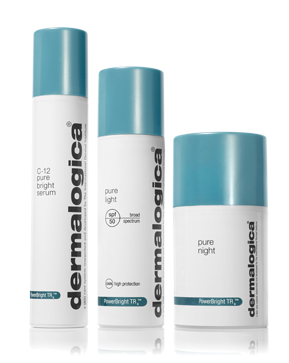Behind the Brown Spot
Hyperpigmentation, which causes skin discoloration and uneven skin tone — may soon surpass wrinkles as the most frustrating sign of aging skin.
Believe it or not, brown spots have a major influence on our looks. In fact, according to a study published in Evolution and Human Behavior, unbalanced skin tone can make a person look more than 12 years older!
The official name for brown spots is hyperpigmentation, which is a scientific way to say regular darkening of skin. Unlike freckles, brown spots do not fade in the winter, and become increasingly more evident as we age. Their cause: overstimulation of melanin (pigment) in the skin.
When produced at regular levels, melanin is what colors our skin, hair and even eyes. But certain triggers can lead to overstimulation and surface color-clumping, which looks darker than our normal tone.
What are these triggers? Number one is unprotected sun exposure. Other triggers include hormonal factors (birth control pills and pregnancy), and post-inflammatory hyperpigmentation (PIH) caused by past trauma or scarring (think a popped pimple or a deep cut). Hormonal pigmentation and PIH are both intensified by sun exposure.
Regardless of their cause, brown spots are as stubborn as blue ink on a white shirt. So, what can be done to reduce their appearance?
call a skin expert
Ask a Renu Day Spa skin therapist trained on Dermalogica products for a Face Mapping® skin analysis and consultation to get to the root of your brown spots. Knowing your personal triggers will reveal the best treatment.
“Tying in a professional series of treatments of peels and products at home can help expedite results”, says Annet King, Director of Global Education at Dermalogica and The International Dermal Institute.
apply spf daily
Sunscreen helps prevent UV light from bringing spots to the surface, and helps control the color intensity of spots you can see. Wear it daily, or you’ll stunt any treatment you try.
“Spending 30 minutes in the sun without proper UVA and UVB (Broad Spectrum) sun protection can undo a month’s worth of effort in the fight against brown spots,” King says. “UV exposure plays a role in all hyperpigmentation issues so wear that sunblock!”
know your ingredients
To safely address brown spots, look for products that contain Retinol and specific peptides that help treat and prevent hyperpigmentation for powerfully-enhanced skin brightening. Magnesium, Ascorbyl Phosphate (MAP), a stable form of Vitamin C, is also helpful for treating hyperpigmentation, scavenging free radicals that cause erratic behavior in melanin-producing cells, and controlling the enzyme activity that produces melanin. And finally, Palmaria Palmata (Red Algae) and Laminaria Ochroleuca (Brown Algae) can help enhance luminosity, refine skin tone and control the processes that contribute to hyperpigmentation. (Note: Hydroquinone, a popular skin-lightening ingredient, is not used by Dermalogica because of its risk of adverse reaction. It has been banned in most of the world due to safety concerns.)
be patient
There’s no quick fix for brown spots. Traditionally, it takes at least 30 days of skin care treatment (with sunscreen use) before you see any progress. In general, 75 percent skin brightening is considered successful and this can take up to four months. Sometimes, spots can look darker before they lighten, as you exfoliate and they begin to surface. Continued use of treatment products such as Powerbright TRx™ can help spots start to fade.
Make an Appointment for Face Mapping With a Renu Day Spa Skin Therapist
Renu Day Spa, 617 Central, Deerfield, Illinois, 60015


